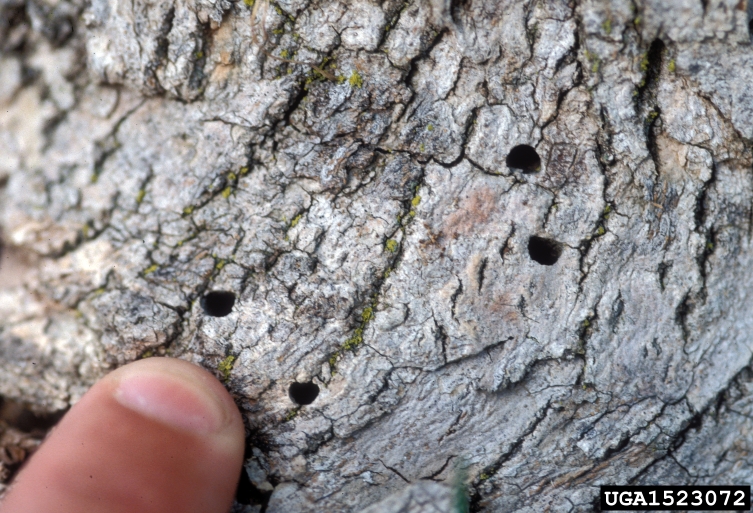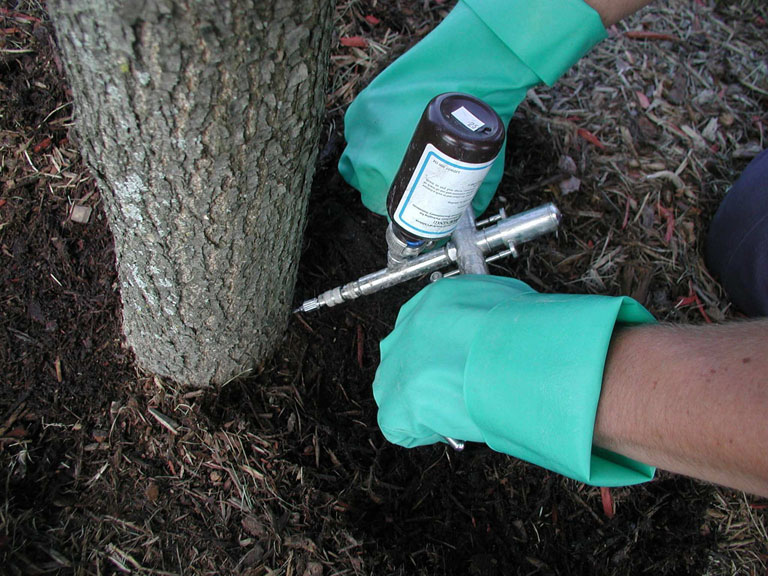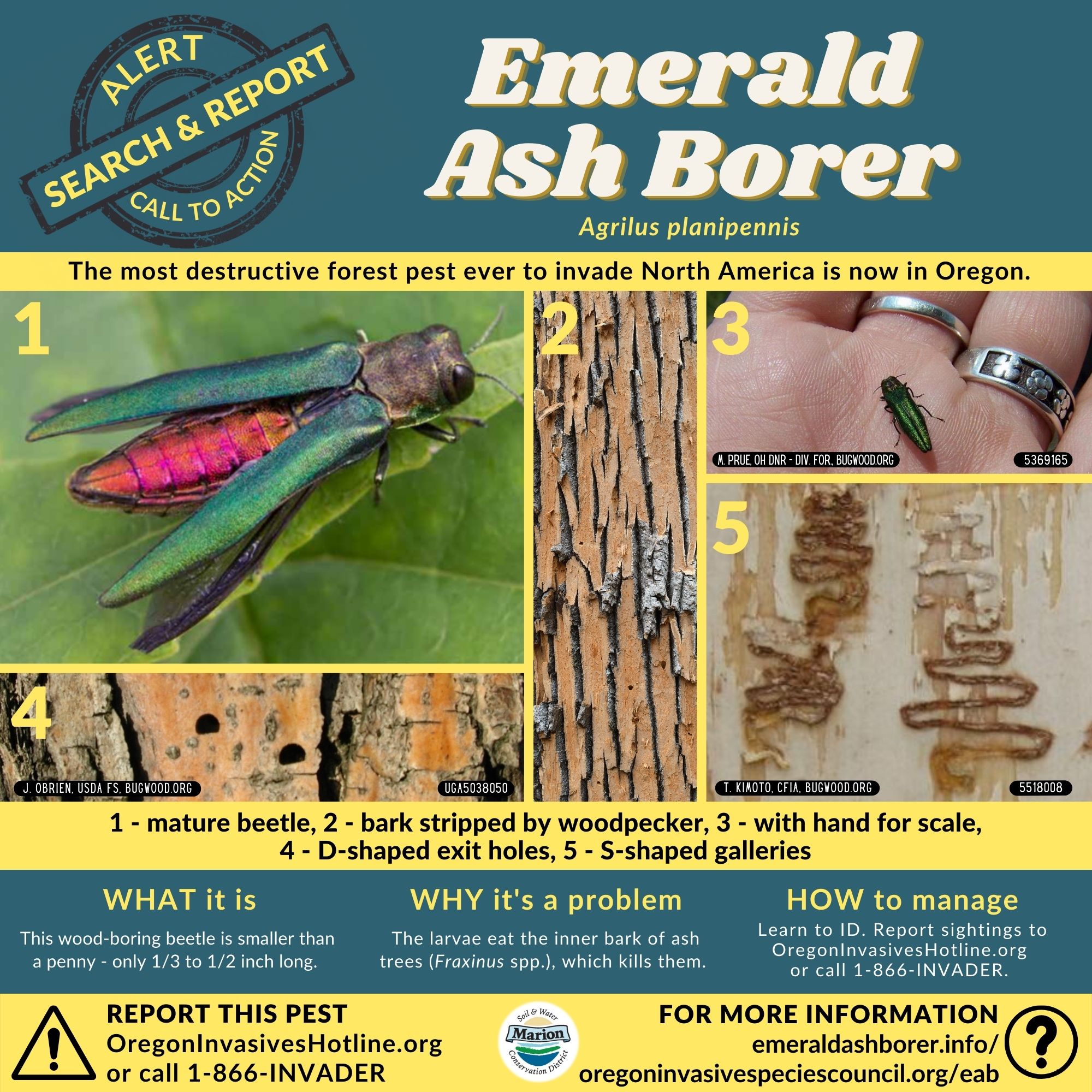Emerald Ash Borer
If you live in the Willamette Valley, you may have heard the warnings of the dreaded Emerald Ash Borer (Agrilus planipennis), which was recently found in Oregon. The first documented sighting was in July of 2022 in a parking lot in Forest Grove. This is the first confirmed Emerald Ash Borer (EAB) infestation west of Colorado. EAB is a pest that has decimated ash trees in the eastern parts of the US since its initial detection in 2002. And now it has found its way here. As of August of 2024, EAB has been confirmed in Yamhill, Marion, and Clackamas counties.

EAB is native to Asia, and it is thought to have been introduced here via wood shipping crates. It infests all species of ash trees, where it lays eggs, which then feed on the inner bark and phloem of the tree, causing rapid crown decline and, ultimately, death of the entire tree. Larvae overwinter in the bark of the ash tree and emerge as adults in late spring. The exit holes of the adults are distinct in that they leave a small “D” shape in the bark of the tree. Depending on weather conditions, from May to October, the adults emerge. Most infest the same or nearby trees, but a few may be able to fly up to ten miles to infest new trees.
Common Concerns and Questions
Should we stop planting ash trees in Oregon?
Not necessarily. While there is a risk of spending a lot of money on ash trees that may likely be killed by the EAB, we are also facing the threat of losing our native ash species entirely if we don’t try to continue to repopulate and save seeds of the trees for future plantings. EAB is known to attack Oregon ash trees at almost every stage of life, from saplings to mature trees. It is important to protect the most vigorous mature ash trees to continue the genetic spread of this tree despite the mortality from EAB. There have been success stories of young ash trees that were planted after the EAB infestation on the East Coast that are still surviving today. Native ash trees may be able to build resistance to the pest, or outlive the infestation, if we continue to plant them.
What is the best tree species to replace native ash?
Although there are no trees that exactly mimic Oregon’s native ash, Fraxinus latifolia, alternative trees can provide similar benefits to the riparian ecosystems where Oregon Ash are most commonly found. It is always important to plant a diverse selection of native trees, shrubs, and forbs for best success.
- For shade and wildlife support: white alder, big-leaf maple, black cottonwood, chokecherry, Scouler’s willow, quaking aspen.
- For tolerance to dry and wet conditions: Oregon white oak, cascara, Willamette Valley ponderosa pine, Pacific madrone.
- Assisted migration candidates to tolerate a changing climate: incense cedar, Oregon Myrtle (also known as California Bay), Canyon live oak and California black oak, which is native to Southwest Oregon.
- For more information, read “Alternatives to Ash in Western Oregon” from OSU Extension Service.
What is the impact of losing ash trees to EAB?
The loss of this native tree species may lead to a number of impacts on environmental and human health.
Environmental impacts
- Loss of shade in streams and rivers, raising temperatures of water.
- Loss of biodiversity in riparian zones, leaving natural spaces vulnerable to establishment of invasive plant species.
- Ash connects landscapes through riparian corridors. The loss of this connectivity will cause stress on various wildlife, soil, and water quality.
- Many urban street trees include various types of ash. Losing significant populations of street and urban trees will cause rising temperatures and further the impacts of climate change in these communities.
Human impacts
- Loss of greenways in urban areas can lead to higher rates of depression and obesity.
- Loss of shade in urban areas can lead to heat islands, increasing the summer temperatures to fatal levels.
- Dead ash trees in urban areas can pose a risk of falling on structures and homes.
What Can Be Done?
Treatment Methods for Dead Trees
- Chip infested ash trees into 1″ by 1″ chips and leave to decompose. The EAB will be cooked in the thermal decomposition of chip piles.
- Burn infested woody debris
- Heat treat woody debris at 170 degrees for 1 hr.
- To process, debark and remove 1″ sapwood for mill.
Prevention and Slowing the Spread
Prevention is possible in some cases. Here are some methods to try to save ash trees:
Buy It Where You Burn It – It is recommended not to move or transport ash wood from May 1st to October 15th when adults are active. To slow the potential spread of EAB and other forest pests, leave firewood at home – do not transport it to campgrounds or parks. Use firewood from local sources. Learn more at Oregon Invasive Species Council.
SLAM (Slow Ash Mortality) – This project in Michigan has been shown to slow the spread of EAB. The ash tree is girdled and a section of bark is removed, to attract adult females looking to lay their eggs. The tree is then injected with insecticide, killing the larvae. The “trap tree” is removed and destroyed to prevent the larvae from completing their life cycle. This has also been successfully done in Forest Grove, Oregon as of 2024; trap trees were girdled, then ash trees near the girdled trees were injected with insecticide. This effectively lured in a concentration of EAB adults laying eggs in these trees to be killed by the insecticide.

Biological control – 4 species of wasp from China and Eastern Russia have been studied as a biological control for EAB. These wasps provide predation on larvae and adults of EAB and have been showing success in slowing the spread in 30 states since the release of eight million wasps in 2007. Sites in Oregon have been selected to release these three types of these wasps in 2025, and additional releases are expected in 2026.
Pesticide injection – In Oregon, systemic injection of emamectin benzoate is highly effective at protecting ash trees from becoming infested with EAB. For more information, view the Multistate EAB Insecticide Fact Sheet.
In Conclusion

It is important to always plant for biodiversity in any natural or urban area to provide resilience against pests and disease that disproportionately impact a particular species. This helps the ecosystem bounce back from disturbance and allows for wildlife to better adapt.
Research into the prevention, treatment and restoration of ash species has been constant since EAB’s US introduction in 2002. The Midwest region of the country has faced the brunt of this invasion and have been able to provide an abundance of scientific information to help us plan for the impacts of EAB. Now that the pest is here in Oregon, we have resources to guide the use of best management practices to help us protect our native ash trees.
As of February 2025, Oregon Debarment of Forestry and Oregon Department of Agriculture in collaboration with other partners have updated a hub website to gather the most important information pertaining to the EAB infestation in Oregon. We encourage anyone who wants to learn more about EAB to start there: Oregoneab.org
Additional Resources
- EAB known infestation map
- ODF Tree health bulletin with EAB updates
- EAB fact sheet
- EAB monitoring guidance
- Oregon Dept. of Agriculture
- Oregon Dept. of Forestry
- OSU Extension
- Emerald Ash Borer Information Network, a collaborative effort by the USDA Forest Service and Michigan State University
- USFS Forest Health Protection
Emerald Ash Borer First Friday Webinar

About the Author

My passion for conservation is rooted in my experiences growing up camping and backpacking every summer since I was young. My favorite activities always involve being outside, whether I am hiking, snowboarding, or biking, I love to explore as much natural beauty as possible. I help Marion County residents improve the health and productivity of their land as the Conservation Planner for natural areas.
